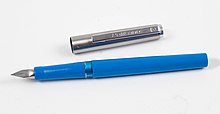Pelikano
Pelikano is the name of a school fountain pen from the Pelikan brand . It was one of the first of its kind and extremely successful in sales.
development
In 1959 the Pelikano was developed on the basis of an extensive survey of educators. This first model was a fountain pen that was specially tailored to the needs of a schoolchild who was just learning to write . The holder couldn't be too heavy for a child's hand. Even with the cap on, the center of gravity had to be as far forward as possible so that the fountain pen would not "tip out" of the hand.
nature
The main innovations on the market for the Pelikano were the spill-proof ink regulator and the cap. It was made of aluminum and was therefore more unbreakable and lighter than the conventional materials hard rubber, celluloid or plastic. The color used was blue / silver, also a result of market research.
distribution
The television advertising used for the first time for a fountain pen made an audience of millions familiar with the Pelikano. Delivery problems quickly arose due to the strong demand. Some of the dealers advertised in the newspaper "Pelikano available again!" In 1964 the company was able to announce in a brochure: "Meanwhile, millions of students write with the Pelikano."
Further development
In 1965 a completely new product was developed and presented. The filler had now received a large vibrating spring that was still strong enough to even the clumsy writing pressure withstand a write beginner.
In terms of appearance, technology, shape and safety in use, the Pelikano model 1965 satisfied the requirements of the time. In the following years there have only been more or less cosmetic changes or adjustments to current tastes.
feather
The spring remained a field of experimentation, as it should be elastic so that the inexperienced hand did not cramp, and it also had to be stable enough so that it did not spread and thus become unusable. The company repeatedly discussed and experimented with teachers and students about the nib shape and shape .
In 1970 the color combination red / silver was added. This met the wish of many parents for a color for girls.
Further changes
Handle profile and left-handed model
In 1973 the grip profile for the index finger was added, which showed the index finger the place as a grooved depression on the front part of the Pelikano . This guaranteed the correct finger position and writing posture. The nib was now less concealed, but was still slightly pointed. For the first time, special models for right and left-handers were also introduced under the names 460 and 461 this year.
In 1984 this writing recess was supplemented with another one for the middle finger and one year later with a "slip brake" for the thumb .
Ink viewing window
In 1989 there was a major technical change with the ink window on the shaft, which provided a view of the ink and reserve cartridges. The new fashion colors were white with a black clip and black feather , mint and pink . In 1990 the blue and red Pelikano models received a gold-plated nib, the mint and pink versions each received a black nib and a black clip.
Pelikano Junior
In the following years there was a certain change in consumer wishes with regard to the “first fountain pen”. It should get a little smaller and lighter again. The Pelikano was bought more for eight to ten year olds. Pelikan responded to this trend with the introduction of the Pelikano Junior , which is aimed specifically at writing beginners. In 2003 the design of the Pelikano was overhauled again.
The Pelikano rollerball
In February 2010, the Pelikano was again completely revised and was the first time beside the fountain pen as a rollerball available.
Web links
swell
- Jürgen Dittmer, Lehmann, Martin: Pelikan writing instruments . AHF Dunkmann GmbH & Co KG, Germany 2004.
- Pelikano website . Pelikan AG . Retrieved January 30, 2011.
